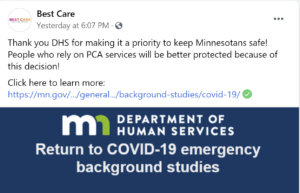You might be surprised to learn that when a client’s social media strategy calls for both Facebook and Instagram – I will write (or coach) those posts to be very similar!
Why?
- This allows you to be efficient with your time and creativity.
- Most fans who follow you on Facebook don’t follow you on Instagram, and vice versa.
- For the fans who do follow you on both Facebook and Instagram, the algorithm will most likely keep them from seeing every single post.
But there are four things you need to do to differentiate your posts between Facebook and Instagram. Today, I’m going to cover how you can take identical content and post it effectively on both of these popular platforms. Let’s dig in!
-
Instagram Uses Hashtags… Facebook, Not So Much.
Hashtags are the most important tool in your toolbox to attract new followers on Instagram. Hashtags allow your business’ content to show up in the feeds of people you want to serve. And, you can utilize up to 30 targeted hashtags in one post!
Click here for an Instagram strategy PDF download.
But hashtags aren’t as important on Facebook. You can use them, but they aren’t nearly as useful for attracting new followers. Instead, hashtags on Facebook are more for branding purposes.
Quick note: Facebook recently made a push for hashtag relevancy, so I’ll be keeping an eye on this development.
Here’s the difference:
-
Instagram Feed Posts Do Not Have Clickable Links
One of my biggest pet peeves is when I see an Instagram post with a long URL in the caption. That link is not clickable, you guys!! Do not waste your time (and frustrate your followers) by including links in your Instagram posts. Instead, when you want your followers to visit a link, find a creative way to “write around” the problem. Here are a few ways you can do it:
Click the link in my bio to learn more.
Visit my website (link in bio) and click “Blog” to read the latest entry.
Want to learn more? Comment “YES” below and I’ll DM you the link!
Wondering where to find that (blog / resource / link)? Comment your favorite emoji and I’ll DM you the direct link.
Ready to read more? Click the link in my bio and then tap (name of button) to get the goods!
There is one exception to this rule: IGTV. Watch this video to learn more.
And take a look at this example of “writing around” the link:
-
Instagram Images Need to be Square – and Extra Attractive!
My mentor (and client!) Andrea Gribble, founder of #SocialSchool4EDU, recently taught that you should always put your best image first in your social media posts. I couldn’t agree more! To “stop the scroll” on both Facebook and Instagram, you should always choose the best possible photo to go with your post. If you’re including more than one image, the very best one should come first.
And on Instagram, you have the ability to add filters. Pretty up those images! Instagram is a very visual-heavy platform.
But here’s the difference: While you can post vertical and landscape images on Instagram – and those images will show up correctly when people are scrolling through their feeds – the best practice is to post square images on the platform. That way, when people visit your profile and check out your grid, all of the important elements of your photos and graphics are shown correctly.
Here’s an example where I chose a horizontal graphic for Facebook but a square graphic for Instagram, to go with the same content:
-
Share Great Content from Others, But Be Careful How You Do It
A great way to build thought leadership in your industry is to curate content from other sources. This blog talks more about how to create a content calendar that includes curated content. You should always provide credit (rule #1!) and make sure the content is actually relevant to your brand.
That being said, “shares” look different on Facebook and Instagram. Here’s how I helped one client post shared content correctly on each platform.
Pro tip 1: I used the free version of the Repost app for the Instagram post.
Pro tip 2: Post a photo on Facebook, first, and then post your caption and link.
One final note: Many scheduling platforms – even Facebook’s own Creator Studio – will allow you to automatically cross-post your Facebook content to Instagram (or vice versa). For the four reasons listed above, I recommend that you do not use this shortcut. Instead, take the extra few minutes to differentiate your Facebook and Instagram posts so they have a better chance of reaching your intended audience and inspiring your fans to engage with your content.
Let me know your thoughts on this! I’d love to hear your input.








